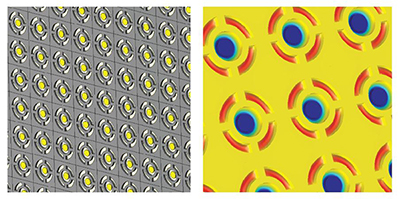
See also the layperson's introduction: Jumping frogs, squeaking bats and tapping woodpeckers and Watching ripples on crystals.
In a joint Korea-Japan collaboration, we have constructed a device that can increase audio sound transmission from water to air by a factor of 160. It is a based on a poker-chip-sized circular plate set with five rubber membranes, and attached to a small cavity separating it from the water surface, giving a total thickness of only 5 millimeters. This sort of composite flat structure is called an acoustic metasurface. This is an example of an acoustic metamaterial, an artificial acoustic material not found in nature, often with peculiar and counterintuitive properties.
The figure belows shows a single element of the constructed metasurface.

Left: schematic diagram of the metasurface element showing a disc containing membranes, one with an attached mass, and a connecting cylindrical air cavity (green). Right: photo of the constructed element of diameter 30 mm (shown reversed).
The reason for sound reflection at an air-water interface is a mismatch in either density or sound velocity, but this can be overcome with a metasurface at the boundary based on our design. When a sound wave reaches it, the metasurface resonates and gives out two reflected waves, one from the hard parts of the metasurface and one from the membranes. These two waves are arranged to cancel out, and allow sound to transmit much more efficiently than through a bare air-water surface.
For a narrow range of frequencies one can make an acoustic metasurface as in the figure below.

Left: schematic diagram of the metasurface. Right: simulation of the vibrations of the metasurface at around 700 Hz . The central membrane moves oppositely to the peripheral membranes. (Blue and red show vibrations in opposite directions.)
For a wide range of frequencies we could use a design with an array of different-sized elements.
We also analysed the acoustic transmission with an analytical model, which agreed well with the experimental results. We are hoping this device can open up entirely new avenues of acoustic communication to or from immersed sound sources. Full details can be found in
'Metasurface for Water-to-Air Sound Transmission' E. Bok et al., Phys. Rev. Lett. 120, 044302 (2018). See also news articles in Science or other journals.